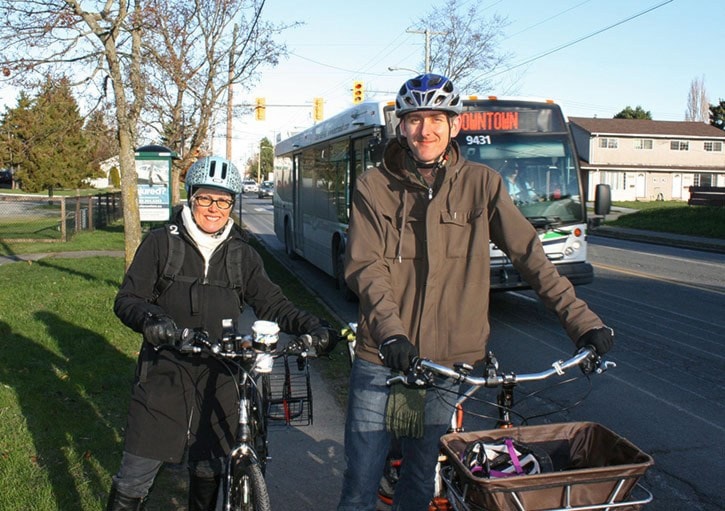Drivers are fuming, while cyclists are geared up over Saanich’s decision to redesign Shelbourne Street with continuous, separated cycling lanes on both sides of Shelbourne from North Dairy to McKenzie, and from McKenize to Torquay.
Council voted 8-1 on Monday night for the $12.5 million hybrid option that will speed up the Shelbourne Valley Action Plan by adding cycling lanes and improved sidewalks, while also narrowing a portion of the busy corridor from four lanes of automobile traffic down to two lanes (plus a third turning lane) between Broadmead/Kisber Avenues (south) and Garnet Road (north). Mayor Richard Atwell was the lone opposition vote.
“If you’re going to come anywhere close to making Shelbourne a people place, where people go to work, shop and be a part of [the neighbourhood], you need to bring it up to date,” said Coun. Vic Derman, who’s had input on the SVAP for years as chair of the Bicycle and Pedestrian Mobility committee. “Shelbourne is tired, parts of it are ugly. It’s primarily shaped to be a conduit [for car traffic] and that’s not an ideal option for a neighbourhood.”
Cindy Marven, a Saanich mom who lives near Sherborne and Torquay, is also behind local non-profit WeBike which started in 2014. The group leads new and nervous cyclists on commuting and recreational rides around town, specifically women.
“We’re really excited about it,” Marven said. “The plans go a long way to making Shelbourne a safer street, for people on foot, and on bikes.”
Marven also believes that Saanich's work will be better appreciated when car commuters recognize that the dedicated bike lanes may improve traffic flow as motorists will not have to change lanes to pass cyclists safely.
Saanich Planning’s community manager Cam Scott is the lead on the project and brought two options, costing about $10 million each, back to council in October 2015. Option 1 retained four lanes of auto traffic and introduced little in the way of new cycle tracks, with a separated bike lane on both sides of Shelbourne Street from Knight Avenue to Pear Street, as well as Feltham Road to Torquay Drive. Option 2 included a ‘road diet’ that narrowed much of Shelbourne to two lanes plus a turning lane.
But neither satisfied council at the time, which asked once again for a hybrid version, if possible. The result is a visionary piece of planning that other municipalities should admire, said Derman.
“It’s a very exciting development that will prove to be really quite visionary in the long term and a big step to getting that corridor reinvigorated,” Derman said.
When Saanich put it to the public in September and October of this year, the survey drew 1,327 respondents. Sixty per cent supported the current plan while 24 per cent support it in part, and 16 per cent did not.
“Shelbourne is one of the best places in the region to create density and this will make it attractive for that type of development and for people to live at,” Derman added.
The option is a part of the $40 million estimate for the Shelbourne Valley Action Plan’s ultimate concept. That will involve repurposing the right-of-ways along Shelbourne, making most curbs wheelchair friendly, and introducing improved sidewalks.
Several residents who spoke at Monday’s council argued that slowing down traffic, namely with a bottleneck from Kisber to Garnet, will cause great distress and will create additional carbon emissions. But Derman disagreed.
“I don’t agree with the belief cars will emit more by slowing down. I was in Amsterdam recently where they’ve made cycling a priority since the 1970s. In six days I was there, I couldn’t find a traffic jam. Yes things slow down, but they have created a cycling and transit-first culture in a city three times the size of [Greater Victoria].”
The timeliness of Saanich’s decision to move forward with the Shelbourne hybrid option comes at the same time the City of Victoria is sprinting forward with its Biketoria cycling infrastructure. A two-way bike lane is currently under construction on Pandora Avenue from Cook Street to Store Street, and in a few months construction will start on a two-way bike lane on Fort Street from Cook to Wharf. It’s drawn criticism in that city as the cycling lanes will run in place of dozens of downtown parking stalls.
Victoria Mayor Lisa Helps said she’s excited to see Saanich take this step forward as her city has been working closely with neighbouring municipalities on bicycle infrastructure investment plans.
Saanich is currently installing a bike lane along Lansdowne to connect to Hillside at the Saanich-Victoria border of Shelbourne.
Mayor goes against the grain
Saanich Mayor Richard Atwell explained his reasoning for voting against the option in a follow up email to the Saanich News.
"As a cyclist and 19-year resident, it is clear to me that there is a great need for infrastructure improvements in the Shelbourne Valley, especially around cycling safety."However, serious outstanding concerns coming from residents and community associations related to unwanted and unintended traffic diversions that are already being experienced due to smaller roadway changes need to be addressed at the front end of this project."In casting my vote, I felt that I needed to lend support to those who have expressed these concerns and to carry them forward to the next stage of planning so that they can be addressed and mitigated as part of the greater planning process."
Now that the short term mobility options are approved, the focus will soon turn to fulfilling the entirety of the Shelbourne Valley Action Plan, which at one point included talk of incentives, but not of expropriation. The concept of expropriation was, however, mentioned as a tool in Saanich's toolkit by CAO Paul Thorkelsson on Monday, but only as a last resort.
travis.paterson@saanichnews.com
